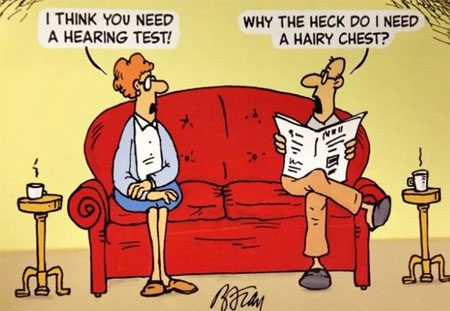-
Hearing
I feel bad for people who were born deaf or, through no fault of their own, became deaf during their lives.
I, however, am one of the many, many people whose (comparatively mild) deafness is down to my own stupidity. My father was deaf as a post, but his wasn’t down to stupidity. It was down to there being no OSHA (Occupational Safety and Health Administration) during his working life. Mill-induced deafness, they called it back then, and it was fairly common. These days they have ear defenders.
(Stupidity continues to abound, however. I was on a bus not long ago, listening to my headphone on a reasonable level, while four seats away a young man was listening to his music through his earbuds, and I could hear the chink, chink, chink of the rhythm over my own music. Invest in hearing aids, I tell anyone who will listen.)

As a very young lad, my hearing was fine. Although I was prone to horrific ear infections which, along with all the aspirin I was taking, caused tinnitus, that’s not what caused my hearing loss; it was the guns. Shooting them off (again, with no ear defenders) caused actual, irreversible, physical damage to my inner ears, and it has grown steadily worse with age. So has my tinnitus which, along with my hearing loss, eventually made it advantageous for me to acquire hearing aids.
They are remarkable, state-of-the-art devices that help me greatly, but I still do not hear as well as you. Therefore, if you are ever talking to me in a pub or noisy restaurant, and I am nodding appropriately, and smiling and laughing in all the right places, it’s still more likely than not that I haven’t got the foggiest idea what you are talking about.
Like many people with a deficiency, I am good at compensating. I do not, however, always need to: when people look straight at me, talk slowly and clearly, and (most importantly) construct logical sentences, I don’t have any problem at all. Sadly, this is not possible, any more than it is possible to have my wife with me 24/7. She is, without a doubt, the best hearing aid imaginable. All I have to do is give her “the look” and she knows that whatever has just been said, was not received by me, and she will immediately interpret. She is amazing but, alas, not always willing to accompany me on a late-night drinking session with my ex-workmates.
Assuming the absence of straight-talking people, and my wife, allow me to attempt to show you what conversation is like for me.
The Word Cloud

If you’re talking to me in a pub, this is what I am hearing.
The Head Turner

Nice and clear, but talking to the room, not to me.
The Fast Talker

Generally, it’s someone behind the counter at Starbucks.
The Unanticipated Phrase

For example: I’ll make a purchase, expect to hear, “Card or Cash,” and instead hear something totally unexpected.
The Mumble

By far the most common.
The one I call “The Rhinoceros is in the Loft”

I heard it, but it doesn’t make any fucking sense.
(I really do call it that, and it refers to those times when I hear a perfectly audible sentence in a conversation that is so bizarre I assume I misheard it, while unbeknown to me, they had been talking about a collection of stuffed animals they’d had as a child and were revealing the current whereabouts of a favourite.)
The Repeat

I heard it, it makes sense, but in hesitating to formulate a response,
the speaker mistakes the two seconds of silence to mean
I hadn’t heard, so they repeat it, louder and slower, again and again.So, if you see me out and about, without my interpreter, and you want to have a coherent conversation with me, simply face me while talking, speak clearly, and don’t tell me about your stuffed rhinoceros.